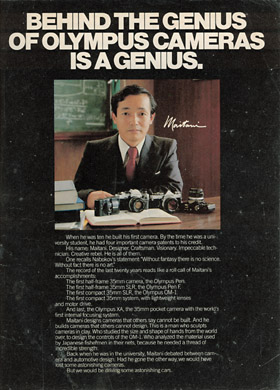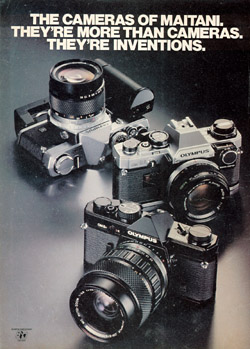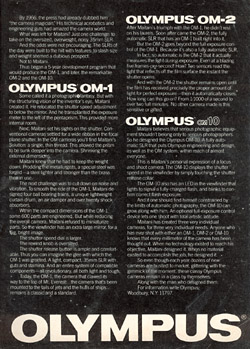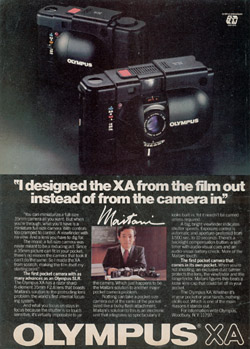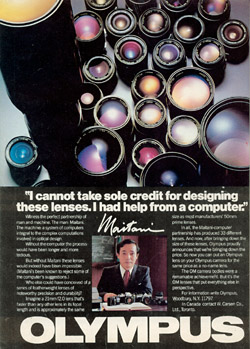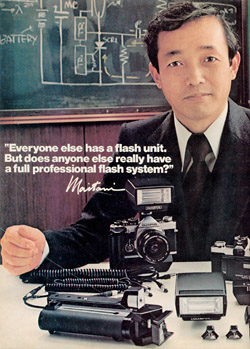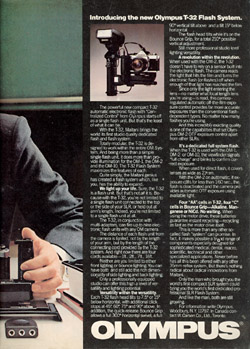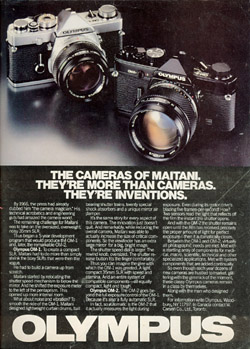|
"Everyone else has a
flash unit. But does anyone else really have a full professional flash
system?"
Introducing the new Olympus
T-32 Flash System.
The powerful new
compact T-32 automatic electronic flash with "Centralized Control" from
Olympus starts off as a single flash unit. But that�s the least of what
it can be.
With the T-32,
Maitani brings the world its first studio quality dedicated flash and
flash system.
Totally modular,
the T-32 is designed to work within the entire OM System. And being
more than a simple single flash unit, it does more than provide illumination
for the OM-1, the OM-2 and the OM-10. The T-32 Flash System maximizes
the features of each.
Quite simply, the
Maitani genius has created a flash system which, like you, has the ability
to expand.
We light up
your life. Sure, the T-32 is a flash unit. But that�s not all it
is. Because with the T32, you�re not limited to a single flash unit
connected to the top or the side of your SLR, or held out at arm�s length.
Indeed, you�re not limited to a single flash unit at all.
The T-32, in conjunction
with multi-adapters, can fire up to nine electronic flash units with
any OM camera.
The distance of
each flash unit from the camera is limited, not by the length of your
arm, but by the length of the connecting cord provided by the T-32 System.
And right now there are four cords available � 1ft., 2t., 7ft., 16ft.
Neither are you
limited to either front lighting or bounce lighting. You can have both
and still add the rich dimensionality of side lighting and back lighting.
Only a professionally
equipped studio can offer this high a level of versatility and lighting
potential.
Versatility
within the versatility. Each T-32 flash head tilts to 7.5degree
or 15degree below horizontal, with additional click stops at 45 degree,
60degree, 75degree and 90degree above. In addition, the quick-release
Bounce Grip allows a full 300degree horizontal swivel, a full 90degree
tilt above and a tilt 15degree below horizontal.
The flash head
tilts while it�s on the Bounce Grip, for a total 210degree possible
vertical adjustment.
Still more professional
studio level lighting versatility.
A revolution
within the revolution. When used with the OM-2, the T-32 doesn�t
have to rely on a sensor built into the electronic flash. The camera
reads the light that hits the film and turns the electronic flash (or
flashes) off when enough of that light has reached the film.
Since only the
light entering the lens � no matter what focal length lens you�re using
� is read, this camera-regulated automatic off-the-film exposure control
provides far more accurate exposures than the conventional flash-dependent
types. No matter how many flashes you�re using.
And this incredibly
exacting quality is one of the capabilities that set Olympus OM-2 OTF
exposure control apart from other SLRs.
It�s a dedicated
full system flash. When the T-32 is used with the OM-1, OM-2, or
OM-10, the viewfinder signals "full charge" and blinks to confirm correct
exposure.
When used for direct
flash, it covers lenses as wide as 21mm.
With the OM-2 on
automatic, if exposure calls for less than 1/60sec., the flash is deactivated
and the camera provides automatic OTF exposure using available light.
Four "AA" cells
in T-32, four "C" cells in Bounce Grip � Alkaline, Manganese or NiCd.
No waiting. When using the motor drive, these batteries guarantee
instant recycling � recycling as fast as the motor drive itself.
This is more than
any other so-called flash "system" can promise. In fact, it makes possible
a broad range of components especially designed for sophisticated medical,
dental, macro, scientific, technical and other specialized applications.
Never before has all this been offered with any other 35mm reflex system.
But there�s nothing radical about radical innovations from Maitani.
Only the man who
brought you the world�s first compact SLR system could bring you the
world�s first dedicated professional SLR Flash System.
And like the man,
both are still growing.
For information
write Olympus, Woodbury, N.Y. 11797. In Canada contact W. Carsen Co.,
Ltd., Toronto.
|

